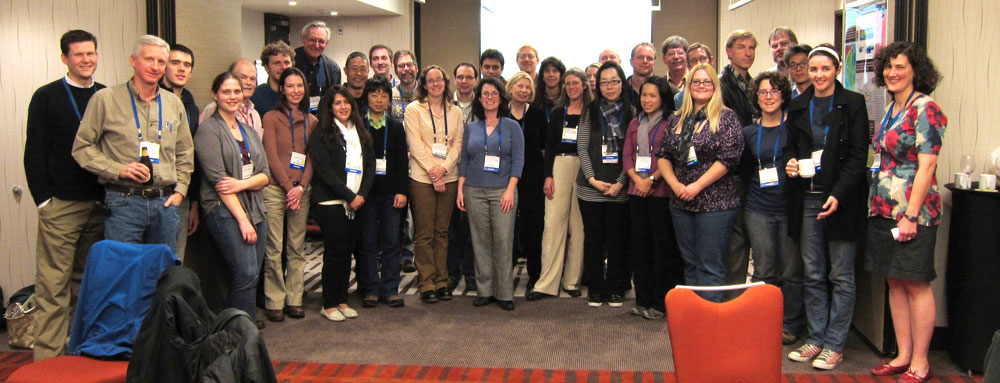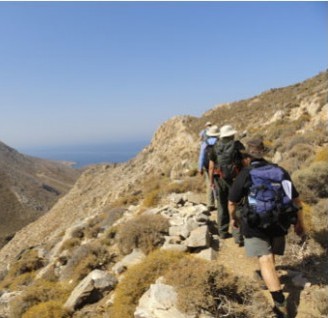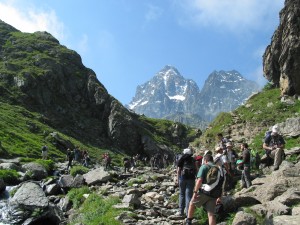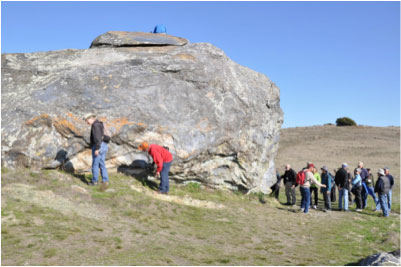Conveners: Maureen Feineman, Sarah Penniston-Dorland, Brian Savage
6:00-6:30 | Greeting, reception, and introduction – Juli Morgan, Maureen Feineman
6:30-7:00 | Keynote: Interdisciplinary study of exhumed subduction zones – Bradley Hacker
7:00-7:30 | First Breakout: identify scientific objectives for ExTerra
7:30-7:45 | Focusing interdisciplinary study through sample and data management – Maureen Feineman
7:45-8:15 | Second Breakout: identify logistical and organizational needs
8:15-8:45 | Synthesis
This mini-workshop, to be held the evening of Wednesday, December 7, during the 2011 Fall Meeting of the American Geophysical Union in San Francisco, CA, aims to explore the interdisciplinary utility of studying exhumed terranes from extinct subduction zones. Exhumed terranes represent parts of the subduction zone that are not directly observable at currently active margins. By going to exhumed terranes, we are able to make direct measurements and observations that can be invaluable for ground-truthing seismic observations, thermal structure models, and interpretations of geochemical and petrological processes based on the eruptive products of active subduction zones. Due to the nature of the dynamic processes that bring exhumed terranes to the Earth’s surface, it is not possible to identify a single locality that represents the full range of subsurface regimes, including the subducted slab, the mantle wedge, the overlying arc crust, and exposed fault systems in the crust or accretionary prism. The goal of this workshop is twofold;
Identify what samples and data will be most useful to the diverse geophysical and geochemical subdisciplines involved in the study of active convergent margins, and
Determine how to best integrate studies of globally distributed exhumed terranes into a unified and directed body of research.
We will discuss in detail the benefits and burdens of sample archiving and data sharing. We encourage participation not only of those involved in the direct observation, sampling, and analysis of exhumed terranes, but also those who would make use of data gathered from these studies, including seismologists, modelers, and experimentalists.
What is ExTerra?
The NSF GeoPRISMS Subduction Cycles and Deformation SCD) Science Plan identified the study of exhumed terranes as an important component of subduction zone research. It remains to be determined how to best integrate the study of exhumed terranes and high pressure rocks into GeoPRISMS SCD. GeoPRISMS largely follows the very effective model used previously by MARGINS of building a research program around a few select focus sites at active subduction zones. This focused research has been a clear strength of the MARGINS program. Work at focus sites, however, may not be the best way to approach exhumed terranes and HP-UHP rocks. During active subduction, these features are buried deep beneath the surface. Of necessity, exhumation most often occurs during or following the death of a subduction zone. The nature of exhumation processes is such that entire subduction zones are rarely if ever exposed in a single location, requiring field work to be conducted at multiple locations, and most likely by multiple research groups using different techniques and approaches, before a comprehensive range of pressure and temperature conditions can be represented. Currently, the study of exhumed terranes is included in the GeoPRISMS implementation plan as a thematic approach. The goal of this meeting is to explore how we can best organize research on exhumed terranes and HP-UHP rocks under the umbrella of GeoPRISMS SCD such that we might accomplish more as a group than we could as individuals working independently.
Context
The GeoPRISMS SCD Implementation Plan identifies the following seven questions to be addressed within the initiative. These should be a good place to start in terms of focusing our research within the context of the SCD initiative.
- What governs the size, location and frequency of great subduction zone earthquakes and how is this related to the spatial and temporal variation of slip behaviors observed along subduction faults?
- How does deformation across the subduction plate boundary evolve in space and time, through the seismic cycle and beyond?
- How do volatile release and transfer affect the rheology and dynamics of the plate interface, from the incoming plate and trench through to the arc and backarc?
- How are volatiles, fluids, and melts stored, transferred, and released through the subduction system?
- What are the geochemical products of subduction zones and how do these influence the formation of new continental crust?
- What are the physical and chemical conditions that control the initiation and development of subduction zones, including subduction initiation and the evolution of mature arc systems?
- What are the feedbacks between surface processes and subduction zone mechanics and dynamics?
Food for thought
The following objectives and scientific questions were identified during the GeoPRISMS SCD Implementation Meeting breakout session on Exhumed Terranes, which took place in parallel with the Focus Site breakout groups. We realized that there were a number of individuals at the meeting working in various disciplines whose work was not easily tied to a focus site in an active subduction zone. Those present fell into one or more of the four sub;fields of research, given below.
- Subducted slab: Includes HP and UHP rocks such as blueschists, eclogites, and metapelites
- Mantle wedge: Includes serpentinites, ophiolites, and peridotites
- Middle and lower arc crust: Includes granitoids and gabbros, migmatites, gneisses, amphibolites, and granulites
- Exhumed fault systems: mostly accretionary prism ?)
- Organizes individual efforts into major interdisciplinary objectives: the whole is greater than the sum of the individuals
- Integrating data from multiple sites allows coverage of a broad range of conditions not observable at a single site
- Links experiments and seismic observation to physical reality: Adds components of space and time / Do the measurements scale up? grain scale to outcrop scale, outcrop scale to seismically resolvable features, days to millions of years
- Enables coupled study of mechanical and chemical processes
- Allows sample and data collection to be tuned to serve the needs of other groups geochemists helping seismologists, petrologists helping modelers, etc…)
- What are the rates and fluxes associated with fluid and melt production as recorded by interaction with rocks?
- What are the mass transfer processes important for global evolution models as well as concentration of ore metals societal relevance)?
- How are tremor and slip recorded in the rock record? What are the geophysical properties of natural rocks velocity structure, anisotropy, fabrics) at a variety of scales?
- How is magma formed and stored in the crust, and how does the crust evolve in response?
- Data and sample management
- Does it make sense to identify unofficial “focus sites” within the community?
- Organize collaborative, multi;disciplinary field campaigns
- “Require” voluntary registration of all samples with the System for Earth Sample Registration SESAR)
- can be linked to ExTerra to make a searchable database of participating samples Interface with existing databases such as MetPetDB?
- Should there be a physical component i.e., a sample repository) linked to the digital archive?
- Alternatively, we can ask for a voluntary commitment to sample sharing within the community
We will split out twice into four breakout groups to facilitate inclusion of everyone in the discussion. Please be prepared to discuss the following issues. The ideas and feelings of the group with respect to these and any other issues/questions that arise will be assembled in a white paper to be submitted to GeoPRISMS.
- How is the study of exhumed terranes relevant and necessary to the objectives of the GeoPRISMS SCD initiative?
- What critical scientific questions can we address using exhumed rocks/terranes?
- How can field geologists interface productively with experimentalists, seismologists, and modelers?
- What data and meta;data do we need to collect and store?
- How can we make data and samples accessible to all?
- Is there a need for a physical, curated sample repository?
- Should we identify key sites for collaborative field efforts? If so, which ones?
- What other efforts e.g. workshops, fieldtrips) would facilitate collaboration?

ExTerra: Understanding Convergent Margin Processes Through Studies of Exhumed Terranes | AGU 2011
ExTerra: Understanding Convergent Margin Processes Through Studies of Exhumed Terranes
AGU Fall Meeting 2011, San Francisco
1Pennsylvania State University; 2University of Maryland; 3University of Rhode Island
On the evening of December 7, 2011, about 35 geoscientists convened in the ExTerra mini-workshop during the fall AGU Meeting to discuss how to integrate the study of exhumed rocks into the GeoPRISMS Subduction Cycles and Deformation (SCD) initiative (Figure 1). After introductory presentations by the convenors and keynote speaker Brad Hacker (University of California, Santa Barbara), workshop participants divided into four groups based on different types of exhumed terranes: subducted slab, mantle wedge, arc crust, and fault systems. The group discussion was divided into two areas: identification of scientific objectives and organizational strategies. Details of the outcomes from each discussion group are outlined at http://www.geoprisms.nineplanetsllc.com/scd/exterra.html. This is an ongoing discussion leading to a white paper contribution to the GeoPRISMS SCD Science Plan, and we invite all interested parties to participate!
What is ExTerra?
The NSF GeoPRISMS Science Plan for the SCD Initiative identified the study of exhumed terranes as an important component of subduction zone research. It remains to be determined how to best integrate the study of exhumed terranes and high pressure rocks into GeoPRISMS SCD. GeoPRISMS largely follows the very effective model used previously by MARGINS of building a research program around a few locations, referred to as primary sites, atactive subduction, these features are buried deep beneath the surface. Of necessity, exhumation most often occurs during or following the death of a subduction zone. The nature of exhumation processes is such that entire subduction zones are rarely if ever exposed in a single location, requiring fieldwork to be conducted at multiple locations, and most often by multiple research groups using different techniques and approaches, before a comprehensive range of pressure and temperature conditions can be represented. Currently, the study of exhumed terranes is included in the GeoPRISMS Implementation Plan as a thematic study. The goal of this mini-workshop and the resulting white paper is to explore how we can best organize research on exhumed terranes under the umbrella of GeoPRISMS SCD such that we might accomplish more as a group than we could as individuals working independently.
What can studies of exhumed systems contribute to GeoPRISMS?
The integration of studies of exhumed systems through GeoPRISMS can organize individual efforts towards major interdisciplinary objectives. Integration of data from multiple sites allows coverage of a broad range of conditions not observable at a single site. Studies of exhumed systems under the umbrella of GeoPRISMS have the potential to link experiments and seismic observation to physical reality, adding the components of space and time. Collaboration and communication between different communities represented within GeoPRISMS allow sample and data collection to be tuned to serve the needs of other groups (geochemists helping seismologists, petrologists helping modelers, etc.).
Target areas
Four target areas have been identified as significant to improving our understanding active subduction processes by the study of exhumed terranes: 1) subducted slab, including HP and UHP rocks such as blueschists, eclogites, and metapelites; 2) mantle wedge, including serpentinites, ophiolites, and peridotites; 3) middle and lower arc crust, including granitoids, gabbros, migmatites, gneisses, amphibolites, granulites; and 4) exhumed fault systems, including accretionary prisms.
Fostering Interdisciplinary Communication
Several different ideas have been suggested in order to facilitate communication among different geoscientists. One idea is to hold focused, interdisciplinary field trips in order to provide the opportunity for non-field geologists to observe exhumed rocks and create an environment for exchange of ideas between field geologists and non-field geologists. Another idea is to create a sample repository and associated database that will allow sample collectors to connect with those who have use for rock samples. For example, experimental petrologists can make use of a sample repository to find materials for their experiments.
Challenges
We recognize that there are many challenges facing the integration of the study of exhumed terranes into GeoPRISMS. How do we open the dialog between petrologists, geophysicists, and modelers? How can studies of worldwide exhumed terranes be related to current GeoPRISMS focus sites? GeoPRISMS is a small program, and we will need to leverage with funds from outside sources.



